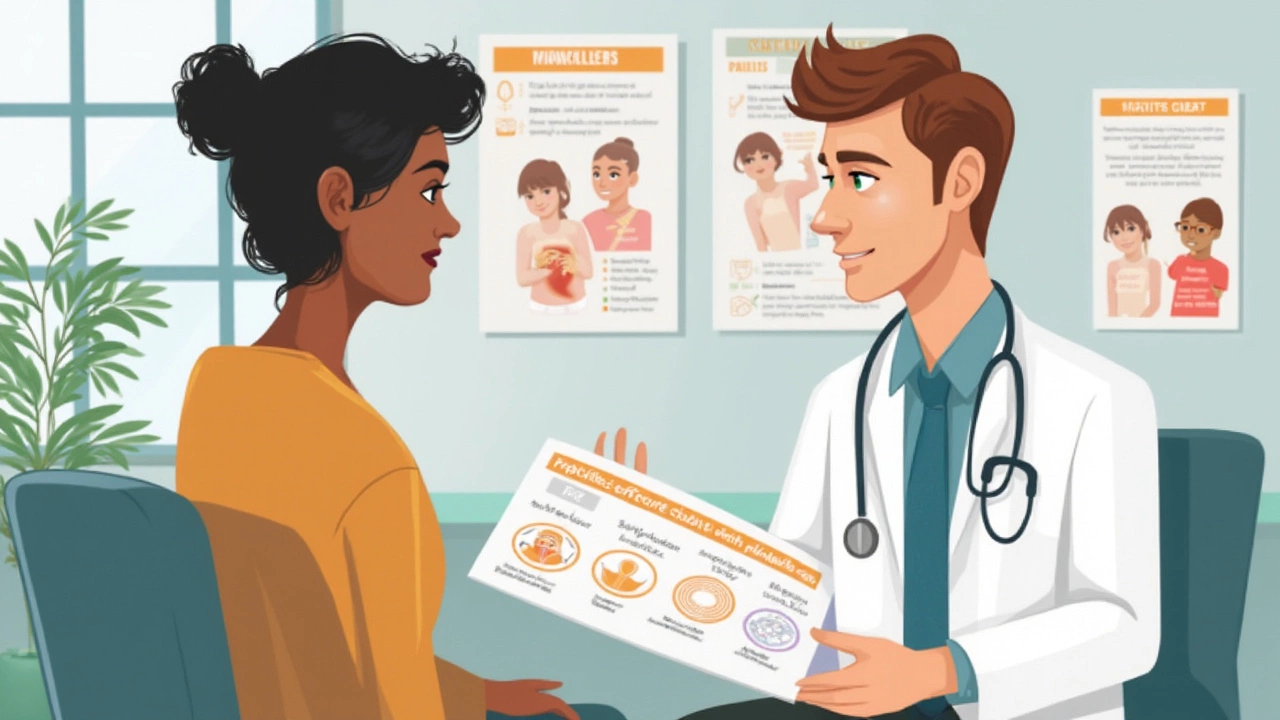 May, 20 2025
May, 20 2025
Pain tablets all claim to make things better, but picking the right one for chronic pain feels more like guesswork than science. Popping what worked last time isn’t always the best idea, especially if the pain just keeps coming back or seems to get worse as soon as the meds wear off. Pharmacy shelves are lined with pills promising fast relief, but not every painkiller is built to handle the grind of daily pain.
If you deal with back pain, arthritis, headaches, or nerve pain that won’t quit, you know the search isn’t about the quickest fix—it’s about finding something you won’t regret taking every day. That means sorting out which tablets really help with long-term pain, which ones are just good for the occasional ache, and how to dodge unwanted trouble like stomach pain or being groggy all day. With so many options—Tylenol, Advil, naproxen, gabapentin, even prescription opioids—the choices can seem endless.
Let’s clear the fog. Here’s how each tablet stacks up, what actually works for real people, and a few things I wish someone had told me before Jasper or I ever reached into the painkiller drawer. No fancy talk, just the essentials you need to find what works for you.
- What Counts as a Pain Relief Tablet?
- The Big Players: Over-the-Counter vs Prescription
- Risks, Side Effects, and What to Watch
- Real-World Tips for Managing Chronic Pain
What Counts as a Pain Relief Tablet?
Not every pain pill is cut from the same cloth. When people talk about tablets for chronic pain, they’re usually thinking of two main groups: stuff you can grab at your local pharmacy and pills that need a doctor’s note.
Let’s break down what’s out there:
- Over-the-counter (OTC) painkillers: These are what most of us first reach for. The big names are acetaminophen (Tylenol), ibuprofen (Advil, Motrin), and naproxen (Aleve). Some folks use aspirin, too. They’re easy to get and usually help with mild-to-moderate pain.
- Prescription pain meds: These pack more punch, and they’re only handed out when regular stuff just isn’t cutting it. Stronger options like opioid tablets (hydrocodone, oxycodone), tramadol, and nerve-pain meds like gabapentin and pregabalin fall under this group. Doctors might also use antidepressants (amitriptyline) and anti-seizure pills for certain types of chronic pain, especially if nerve endings are involved.
When docs talk about “chronic pain,” they mean pain that sticks around for at least three months. Because of that, the key isn’t just knocking the pain down once—it’s finding a balance between relief and safety if you’re using pills long term.
Here’s a cheat sheet showing how these pain tablets stack up for chronic pain. See how each type is usually used:
| Tablet Type | Common Brand Names | Main Use | How They're Dosed |
|---|---|---|---|
| Acetaminophen | Tylenol | Everyday aches (back, joints, headaches, arthritis) | Up to 3,000 mg/day |
| NSAIDs | Advil, Aleve | Inflammation pain (joint, muscle) | 400–600 mg every 6–8 hours (ibuprofen) |
| Opioids | OxyContin, Vicodin | Severe, hard-to-treat pain | By doctor only—short courses |
| Gabapentin/Pregabalin | Neurontin, Lyrica | Nerve-related pain (sciatica, fibromyalgia) | Start low, increase as needed |
| Antidepressants | Elavil (amitriptyline) | Nerve and migraine pain | Low dose, usually at night |
Keep in mind, what counts as the best tablet for chronic pain really depends on the cause of your pain, what else you’re dealing with health-wise, and how your body reacts. That’s why the list is so long—and why it takes some trial and error before you find your sweet spot. It’s way more than just grabbing whatever’s in the medicine cabinet.
The Big Players: Over-the-Counter vs Prescription
Most folks dealing with ongoing pain start off with the classics—the over-the-counter stuff. Walk into any grocery or drugstore, and you’ll spot acetaminophen (that’s Tylenol) and nonsteroidal anti-inflammatory drugs, or NSAIDs, like ibuprofen (Advil, Motrin) and naproxen (Aleve). These are the everyday go-tos for things like muscle aches, mild arthritis, and even those never-ending headaches.
Acetaminophen is often first in line for chronic pain since it’s pretty easy on the stomach and doesn’t thin your blood. But here’s the catch: it’s not great for swelling, and it’s got a strict limit—go over 3,000 to 4,000 mg a day, and your liver won’t thank you. NSAIDs, on the other hand, do a solid job knocking down swelling and pain, but can mess with your stomach, kidneys, and even your heart if you use them every day or at high doses.
Now, for pain that refuses to quit or when nerve pain is involved (think fibro, nerve injuries, or sciatica), doctors often pull out the prescription playbook. This might mean drugs like gabapentin, pregabalin (Lyrica), or low-dose antidepressants that mess with pain signals instead of just blocking them. Some folks get prescribed opioids, but that’s usually for severe pain and only when other meds don’t work, because addiction and side effects are real worries.
Quick breakdown of what people actually end up using:
- Acetaminophen (Tylenol): Good for mild pain, less helpful for anything swollen.
- NSAIDs (Ibuprofen, Naproxen): Tackle pain plus swelling; trouble is, long-term use can be rough on the gut and heart.
- Gabapentin/Pregabalin: Used if nerves are the culprit. Not quick fixes—takes a few weeks to kick in for most people.
- Low-dose Antidepressants (like amitriptyline): Sometimes help nerve and migraine pain, even if you’re not depressed.
- Opioids: Strongest pain relief, but risky for long-term use unless other options really fail. Doctors watch these like hawks.
What works depends on what’s at the root of your pain and how your body handles side effects. Never hurts to check in with your doctor before mixing and matching, especially if you’re already juggling other meds. And don’t expect a single tablet to be the magic bullet—sometimes the best results come from using more than one thing together, and throwing in non-drug stuff like movement and heat packs.

Risks, Side Effects, and What to Watch
You’ve probably heard someone say, “It’s just Tylenol” or “Ibuprofen can’t hurt you.” The thing is, even the most common pain tablets come with risks—sometimes pretty serious ones—especially if you’re using them day after day. Chronic pain usually needs long-term treatment, so you have to pay attention to the downsides as much as the possible relief.
Let’s hit the basics first. The most used painkillers—acetaminophen (Tylenol), ibuprofen (Advil), and naproxen (Aleve)—have some well-documented side effects when you use them a lot. Here’s what the science and doctors warn about:
- Acetaminophen (Tylenol): Too much can damage your liver. Even slightly more than recommended, taken over time, can sneak up on you. The danger’s even higher if you combine it with alcohol.
- Ibuprofen & Naproxen: These are NSAIDs (nonsteroidal anti-inflammatory drugs), and stacking them too often can lead to stomach ulcers, bleeding, or kidney problems. People over 65, or who have heart or stomach issues, need to be extra careful.
- Prescription Opioids (like oxycodone or hydrocodone): These work, but addiction can happen fast—even when taken as prescribed. Constipation, drowsiness, and higher chance of falls show up quickly. Overdose risk is real if you mix them with alcohol, sleep meds, or anxiety pills.
- Gabapentin & Pregabalin: Used a lot for nerve pain, these can leave you dizzy, sleepy, or clumsy. Some folks feel foggy-headed or even depressed. Feeling dopey isn’t always worth the trade-off.
Here’s a quick look at how these common pain tabs stack up on risks, especially if you’re managing chronic pain long-term:
| Tablet | Most Common Risks | Who Should Avoid |
|---|---|---|
| Acetaminophen | Liver damage, especially with alcohol | People with liver problems, heavy drinkers |
| Ibuprofen/Naproxen | Stomach ulcers, bleeding, kidney issues | Over 65, those with heart/kidney/stomach issues |
| Opioids | Addiction, overdose, falls, constipation | History of addiction, combining with sedatives |
| Gabapentin/Pregabalin | Sleepiness, dizziness, balance trouble | Older adults, people with depression |
If you ever notice yellowing skin, black stools, trouble breathing, or confusion—those are big red flags. Stop taking the tablet and get help. Don’t be shy about talking to your doctor or pharmacist, even if something seems minor. Most people aren’t expecting side effects until they land in their lap, or worse, in the ER. Better to ask twice than deal with regret later.
One last tip: keep a list of everything you’re taking, including over-the-counter stuff and supplements, and show your doc. Mixing meds can crank up your risk for problems without you even knowing it.
Real-World Tips for Managing Chronic Pain
Pain tablets aren’t magic, and anyone who’s tried to power through a day with a sore back or throbbing joints knows the wrong pill can make things worse. Living with chronic pain isn’t about popping the most powerful tablet you can get your hands on. It's about mixing meds with simple tricks that actually help.
First, be picky with painkillers. Acetaminophen and NSAIDs like ibuprofen are usually safest for daily use, but never go above the label dose—stomach bleeding and liver damage are real risks, especially if you’re doubling up without realizing it. Don’t use opioids unless there’s no other choice and your doctor is on board for the long haul. A 2022 CDC report found almost 11% of US adults use some kind of pain tablet every week, but most stick with over-the-counter brands for a reason: fewer nasty side effects.
Tracking what you take helps a ton. Make it simple—write it on your phone, old-school sticky note, whatever. Here’s a quick log idea:
| Time | Tablet | Dose | How You Felt |
|---|---|---|---|
| Morning | Ibuprofen | 400mg | Less stiff, but a little stomach pain |
| Afternoon | Acetaminophen | 500mg | No headache, felt alert |
Next, don’t skip basics because they sound boring. Using heat packs, stretching for 10 minutes, or going for a short walk usually brings more steady relief than any single tablet. Plus, moving a little each day keeps muscles from locking up or joints getting stiffer.
Here’s what helps most folks keep pain off their mind:
- Switch painkillers every few days if your doctor says it’s okay, so you don’t overload one system (like your stomach or liver).
- Watch for hidden pain triggers: bad shoes, weird sleep positions, or even carrying your kid’s giant backpack just because “It’s easier, Dad.”
- Stick to a bedtime routine—being tired can make pain worse and tablets less effective.
Finally, don’t tackle pain by yourself. Doctors, physical therapists, or even online support groups can point out tricks you’d never think of—like ice vs. heat for nerve pain, or how gadgets like TENS units fill in where tablets fall short.
